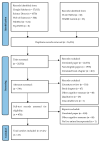Can Interacting with Animals Improve Executive Functions? A Systematic Review
- PMID: 37443878
- PMCID: PMC10339988
- DOI: 10.3390/ani13132080
Can Interacting with Animals Improve Executive Functions? A Systematic Review
Abstract
There has been growing interest in the potential benefits of using human-animal interactions to improve executive functions: cognitive processes that allow individuals to plan, solve problems, and self-regulate behaviour. To date, no comprehensive review has been conducted. The purpose of this study was to evaluate existing literature, adopting broad inclusion criteria. Following Preferred Reporting Items for Systematic Reviews and Meta-Analyses (PRISMA) guidelines, 16 papers were identified from peer-reviewed literature. Additional papers were identified from grey literature, including 6 dissertations and 1 thesis. A review of these 23 studies found that human-animal interactions and executive functions are investigated in three main ways: (1) exploring the potential benefits of the human-pet relationship, (2) exploring the impact of an animal's presence during administration of executive function tests, and (3) evaluating the efficacy of animal-assisted services (e.g., animal-assisted therapy) on executive functions. Five of the included studies reported a significant improvement across all measured domains of executive functions, but effect sizes were underreported. Comparatively, 9 studies reported mixed findings, d = 0.32-0.55, while 8 studies reported no significant results. The overall rigour of the research was limited, with great heterogeneity between the study methodologies and outcome measures used. It is recommended that future studies utilise high-quality research methodologies through the use of randomisation, pre- and postmeasures, and appropriate control conditions, where possible.
Keywords: adolescence; animal-assisted services; children; cognition; development; human–animal relationship; human–pet relationship; older adults.
Conflict of interest statement
The authors declare no conflict of interest.
Figures

References
-
- Diamond A. Executive functions. In: Gallagher A., Bulteau C., Cohen D., Michaud J.L., editors. Handbook of Clinical Neurology. Elsevier; Amsterdam, The Netherlands: 2020. pp. 225–240. - PubMed
-
- Diamond A. The early development of executive functions. In: Bialystok E., Craik F.I.M., editors. Lifespan Cognition: Mechanisms of Change. Oxford University Press; Oxford, UK: 2006. pp. 70–95.
Publication types
LinkOut - more resources
Full Text Sources

